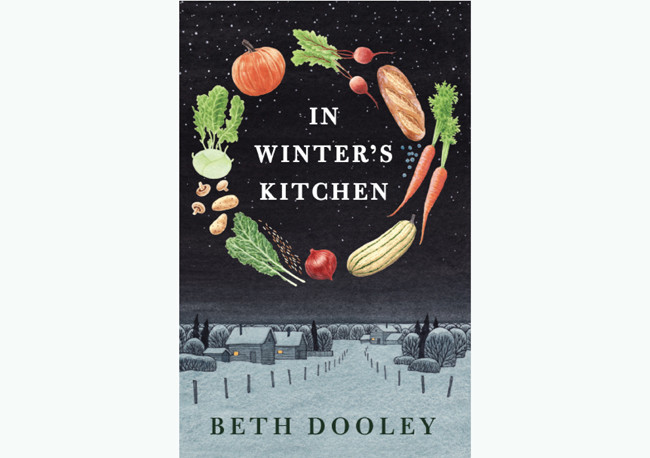
In a recent essay in The New York Times, chef Jacques Pépin talked about how meals are fleeting, “You make it, it goes, and what remains are memories.” For him, for all of us, ingredients and dishes are forever associated with people and times in our life, and tastes and smells — even the seasons — have the power to evoke those food memories. “These memories are essential for the cook, the food critic, and the writer,” Pépin says. “They enrich your day-to-day life and your relationships with your family and friends.”
This quote came to mind reading Beth Dooley’s latest book, In Winter’s Kitchen ($25, Milkweed Editions, 2015), in which she uses food memories, friendship, and family as a way into conversations about our food system. Fans of the local author will be surprised to learn this is not a cookbook — though there are some recipes — but a kind of hybridized memoir.
The book opens as Dooley is moving from Princeton, N.J., to the Twin Cities with her new husband. She is already a bit of a foodie, and she leaves with her mother’s copy of Joy of Cooking — and her father’s permission to host the next Thanksgiving. Preparing for the holiday will give her new adventure focus, she thinks. But her first encounters with the food scene here are not inspiring. In fact they read like a Midwestern cliché: “… the Red Owl grocery stocked disappointing soft apples and wimpy carrots, aisles of frozen dinners and shelves of packaged mac and cheese. We had landed in ‘the nation’s breadbasket’ only to find it filled with tasteless white bread.”

Happily, it was not long before Dooley discovered the Minneapolis Farmers Market and began the thirty-five year relationship with the local food movement that has resulted in a six cookbooks. In Winter’s Kitchen is about the friends who support and influence her as she makes that journey — and all of the family and life that happens along the way.
It’s also about the food. Dooley has organized her stories around the twelve raw ingredients of her family’s traditional Thanksgiving meal (corn, turkey, milk, and the like). Thus each chapter focuses on a single ingredient and weaves food memories together with profiles of producers, food history, and related issues — from gluten intolerance and the difficulties of selling raw milk to the farm bill and GMO seeds.
The result is a book that feels alternately like a poignant trip down food memory lane and an inspiring field trip to the farms and factories of the people who are trying to change our food system. And yet it works. Dooley’s tasty food memories and stories of real people bring home all the reasons why we should care about things like crop diversity — but they’re also just plain interesting.
One of the most engaging chapters of the book is “Chestnuts.” The last stand of true American chestnut trees is in Wisconsin. It’s descended from an orchard planted by a settler in the 1800s, but it’s dying of a blight. Dooley writes about how the American Chestnut Foundation developed an Americanoid chestnut that produces nuts of the same creamy texture and delicate sweetness as those of the old American chestnut. It’s also something of an ecological wonder, protecting soil from drought, flooding, and erosion, replacing important soil nutrients, and providing harvestable wood — not to mention dropping 6,000 nuts a season. All things this reader did not know.
Many of the people in these stories have become Dooley’s friends, and she portrays them with respect and evident delight. The Americanoid chestnuts are growing on the Minnesota farm of Philip Rutter, a founder of the American Chestnut foundation and a biologist and ecologist, who helped developed them. Dooley captures his voice beautifully, such as when he talks about a tractor he designed to harvest the chestnuts: “We had a few false starts trying to get the level of the pickers right. The brakes needed adjusting, and we nearly lost it on a steep hillside, ran like crazy, shouting after it. Course it wouldn’t listen.”
In Winter’s Kitchen may lead readers to new food experiences, such as the gonzo Cranberry Festival in Warrens, Wis., a black Spanish heritage turkey from Brandon Severson, a block of butter from Hope Creamery, or one of Love Tree’s stinky cheeses. And at the back of the book, there are Thanksgiving recipes using each of the book’s twelve foods.
In the end though, it seems as if Dooley is hoping the book will inspire reflection and action of a different kind. This is after all a book about Thanksgiving. She ends the book on a note of gratitude for her friends and family — and all of the meals, joy, and troubles they’ve shared — and appreciation for the region “that gives its food so reluctantly.” She writes: “My Thanksgiving table helps me understand what a vibrant, viable, and delicious local food system looks like in a climate where the land freezes hard for six months a year, a land where industrial farms and global food companies are front and center. … Yet here in this place, by connecting with small farmers and growers, through our own foraging and gardening, we’re rediscovering the beauty and pleasure in nature’s bounty that may inform different and more positive decisions as we cook meals, vote for our leaders, and engage with each other.”


Pagani on Dooley, what a perfect fit. I thoroughly enjoyed reading this, and look forward to picking up Beth’s book. Cheers~ Brett